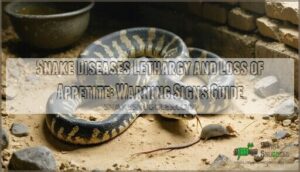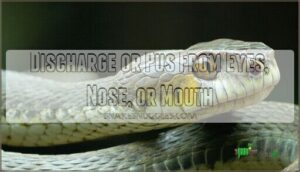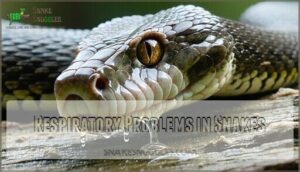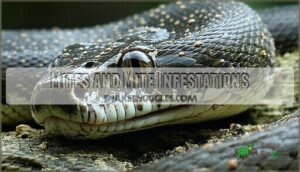This site is supported by our readers. We may earn a commission, at no cost to you, if you purchase through links.

These symptoms often signal underlying health issues like respiratory infections, which can cause mouth breathing, nasal discharge, and that telltale "gurgling" sound.
Snake diseases lethargy and loss of appetite can also indicate skin conditions, digestive problems, or bacterial infections like mouth rot.
Your pet’s refusal to eat combined with unusual sluggishness means it’s time to evaluate their environment and overall health status.
Understanding what these symptoms reveal about your snake’s condition can help you respond quickly and effectively.
Table Of Contents
- Key Takeaways
- Snake Diseases Overview
- Signs of Illness in Snakes
- Respiratory Problems in Snakes
- Skin Conditions in Snakes
- Digestive Issues in Snakes
- Viral and Bacterial Infections
- Injuries and Wounds in Snakes
- Difficulty Shedding and Dysecdysis
- When to Seek Veterinary Care
- Frequently Asked Questions (FAQs)
- Why is my snake lethargic and wont eat?
- What are the symptoms of the Reptarenavirus?
- What are the symptoms of stomatitis in snakes?
- What are the symptoms of malnutrition in snakes?
- What are the symptoms of paramyxovirus in snakes?
- What causes lethargy in snakes?
- Why is my snake so active and not eating?
- Why is my snake struggling to eat?
- How do environmental factors affect a snakes appetite and lethargy?
- How often should I monitor my snakes behavior for signs of illness?
- Conclusion
Key Takeaways
- You’ll spot trouble early when your snake shows lethargy and won’t eat – these are serious warning signs that often signal respiratory infections, skin conditions, or bacterial diseases requiring immediate veterinary attention.
- Your snake’s environment directly impacts its health – temperature drops below 70°F, poor humidity levels, inadequate ventilation, and dirty enclosures create conditions that lead to illness and appetite loss.
- You shouldn’t wait when symptoms appear together – lethargy combined with loss of appetite indicates your snake needs professional care, as conditions like pneumonia, mouth rot, and parasitic infections can deteriorate rapidly without treatment.
- You’ll prevent most health issues through proper husbandry – maintaining correct temperatures, humidity levels, clean enclosures, and regular veterinary checkups catch problems before they become life-threatening emergencies.
Snake Diseases Overview
When you notice your snake showing lethargy and loss of appetite, you’re witnessing two of the most common warning signs of illness in reptiles.
These symptoms can indicate everything from minor husbandry issues to serious infections that require immediate veterinary attention, often signaling a need for immediate care.
Common Health Issues in Snakes
Regarding snake health problems, you’ll want to watch out for a few repeat offenders.
Most cases boil down to husbandry problems, stress factors, diet deficiencies, parasite prevention gaps, or genetic predispositions.
The most common snake illness symptoms include:
- Breathing trouble
- Irregular skin shedding
- Lethargy or low activity
- Appetite loss and digestion issues
Importance of Veterinary Care
Regular veterinary care forms the backbone of snake health management. A reptile specialist provides specialized expertise that general vets often lack, offering proper snake veterinary care adapted to your pet’s needs.
Professional reptile veterinary care guarantees:
- Early diagnosis of subtle health changes before they become serious
- Preventative care programs including parasite screening and wellness exams
- Access to advanced treatment options for snake lethargy and appetite loss
- Long-term health monitoring to catch problems early
Prevention and Early Detection
Prevention starts with smart quarantine protocols for new snakes and consistent habitat maintenance.
Monitor your snake’s behavior daily—watch for changes in appetite, movement, or shedding patterns that signal trouble.
Regular checkups with an exotic veterinarian catch snake diseases early, while proper nutritional balance strengthens immune systems.
Early detection through preventative measures saves lives.
Signs of Illness in Snakes
Recognizing illness in your snake requires careful observation of subtle changes in behavior and physical appearance.
Early detection of symptoms like lethargy, appetite loss, or unusual discharge can mean the difference between a quick recovery and a serious health crisis, which is why it is crucial for the snake’s well-being to identify these signs promptly, including unusual discharge.
Lethargy and Loss of Appetite
Lethargy and Loss of Appetite signals trouble in your snake’s world.
When your pet snake shows lethargic behavior or refuses food, check temperature impact and hydration status first.
Cold environments below 70°F cause sluggishness, while dehydration creates wrinkled skin.
Handling stress and poor enclosure enrichment suppress snake appetite loss.
Some species naturally show brumation signs seasonally, but sudden decreased appetite warrants veterinary attention immediately.
Parasitic infections, such as mites, can also lead to weight loss and lethargy.
Changes in Skin Color and Texture
Your snake’s skin tells a story about its health.
Watch for discoloration patterns like unusual dark spots, fading colors, or reddish areas that signal Scale Rot or Blister Disease.
Texture changes include raised bumps, soft patches, or rough scales indicating skin conditions.
Abnormal growths, swelling, or missing scales need immediate attention.
These reptile skin problems often stem from poor humidity, dirty enclosures, or underlying snake diseases requiring veterinary care.
Discharge or Pus From Eyes, Nose, or Mouth
Nasal discharge and pus consistency around your snake’s eyes, nose, or mouth signals trouble.
Eye infections produce thick, cloudy discharge, while oral infections like stomatitis create foul-smelling pus.
Discharge color matters – yellow or green indicates bacterial infection.
These snake disease symptoms often accompany respiratory problems, making prompt snake veterinary care essential for recovery.
Abnormal Swellings and Masses
When unusual lumps appear on your snake’s body, these abnormal swellings and masses signal potential snake diseases requiring immediate attention.
These growths can indicate infections, tumors, or parasitic issues affecting your reptile’s health.
Common causes of abnormal swellings include:
- Abscess identification – Pus-filled pockets from bacterial infections requiring drainage and antibiotic treatment
- Cyst types – Fluid-filled sacs from blocked glands that may need surgical removal
- Tumor diagnosis – Abnormal tissue growth requiring imaging tests and possible biopsy for confirmation
- Granuloma formation – Inflammatory tissue response to foreign materials or chronic irritation
- Hematoma causes – Blood-filled swellings from trauma or injury affecting snake health
Monitor these reptile health problems closely and consult your veterinarian immediately for proper diagnosis and treatment of snake disease symptoms.
Respiratory Problems in Snakes
Respiratory infections are among the most serious health threats your snake can face, often appearing alongside mouth rot and causing rapid deterioration if left untreated.
You’ll notice symptoms like excess mucus around the nostrils, open-mouth breathing, and increased lethargy that signals your pet needs immediate veterinary attention, which is crucial for preventing further deterioration.
Pneumonia Symptoms and Treatment
Recognizing pneumonia early saves your snake’s life. Watch for open-mouth breathing, bubbling from nostrils, and audible wheezing. These respiratory problems signal bacterial pneumonia, viral pneumonia, or fungal pneumonia.
Pneumonia diagnosis requires immediate veterinary care. Treatment options include targeted antibiotics for bacterial infections, supportive oxygen therapy, and controlled temperatures. Snake diseases like respiratory disease demand professional intervention—home remedies won’t cut it for serious snake respiratory issues.
A key factor in prevention is maintaining optimal temperature gradients within the enclosure.
Symptoms Treatment Recovery
Causes of Respiratory Issues
Several environmental factors and pathogens trigger snake respiratory issues.
Poor ventilation creates stagnant air that harbors harmful organisms, while stress weakens your snake’s immune defenses against disease.
- Bacterial infections thrive in dirty, humid environments with inadequate airflow
- Fungal exposure occurs when moisture levels remain consistently too high
- Viral pathogens spread easily between snakes in overcrowded or unsanitary conditions
Environmental factors like temperature fluctuations also compromise respiratory health.
How to Prevent Respiratory Problems
**Prevention starts with environment.
Maintain stable temperature gradients between 75-85°F and humidity levels of 50-60%. Make certain proper ventilation without drafts.
Quarantine new snakes for 60 days to prevent disease spread. Keep enclosures clean and stress-free with adequate hiding spots. You can find humidity control products to help maintain the correct environment.
| Prevention Method | Target Range | Frequency |
|---|---|---|
| Humidity control | 50-60% | Daily monitoring |
| Temperature gradients | 75-85°F | Continuous maintenance |
| Quarantine protocols | 60 days minimum | Every new addition |
Regular veterinary check-ups help catch respiratory problems early, protecting your snake’s health long-term.
Skin Conditions in Snakes
Skin problems in snakes often connect directly to lethargy and appetite loss, making early recognition essential for your pet’s health.
You’ll notice these conditions typically develop from poor environmental conditions, parasites, or infections that stress your snake’s immune system.
Mites and Mite Infestations
Snake mites (Ophionyssus natricis) appear as tiny black specks crawling on your snake’s skin, particularly around eyes and nostrils.
Looking at the paragraph about snake mites, here’s a short, engaging blockquote in the same tone:
**These blood-sucking parasites turn your pet snake into a walking disease carrier.
These parasites cause lethargy through blood loss and can transmit serious diseases like paramyxovirus.
Understanding their life cycle stages is essential for effective management.
Early mite identification prevents secondary infections that compromise your snake’s immune system.
Proper enclosure hygiene and quarantine protocols serve as essential preventative measures against these persistent skin conditions.
Skin Infections and Abscesses
Skin infections and abscesses develop when bacteria invade damaged skin, creating pus-filled blisters and swollen areas.
Bacterial dermatitis and blister disease often stem from overly moist environments, while scale rot appears as darkened, deteriorating scales.
Abscess treatment requires veterinary drainage and antibiotics.
Preventative hygiene includes maintaining proper humidity levels and clean substrates to prevent these snake diseases.
Shedding Issues and Dysecdysis
While skin infections affect your snake’s exterior, shedding issues impact the entire molting process. Dysecdysis occurs when snakes can’t shed properly, often due to low humidity levels or poor health. Retained eyecaps pose serious risks and require immediate veterinary attention.
Monitor your snake’s shedding frequency and adjust care accordingly. Snakes often exhibit bluish-gray eyes as a sign of an impending shed.
- Humidity levels should reach 50-60% during shedding cycles to prevent stuck shed
- Handling techniques must be gentle when assisting with problem areas
- Supplementation needs may include calcium or vitamin A deficiencies affecting shed quality
- Snake diseases like mites or infections often complicate the shedding process
Digestive Issues in Snakes
Your snake’s digestive system can signal serious health problems when things go wrong. Understanding constipation, appetite loss, and bacterial risks helps you spot trouble early and take action.
Constipation Causes and Treatment
Constipation hits your snake when dehydration effects combine with inadequate dietary fiber and improper temperatures.
Impaction causes include ingesting substrate or oversized prey. You’ll notice decreased appetite and hard, dry droppings.
Treatment involves warm water soaks, gentle massages, and sometimes enema usage under veterinary guidance.
Probiotics benefits include restoring gut health after treatment.
Anorexia and Lack of Appetite
When your snake stops eating, you’re facing anorexia – a common issue with multiple causes of anorexia including stress, temperature changes, or underlying illnesses.
This refusal to feed signals deeper problems requiring attention.
Appetite stimulants may help, but force-feeding snakes should only be done by professionals.
Monitor your snake refusing food carefully and consult a veterinarian promptly.
Salmonella Risks and Prevention
While appetite loss might seem like just a feeding problem, over 92% of captive snakes carry Salmonella bacteria, creating serious human infection risks.
This common reptile disease demands strict hygiene practices to protect your family’s health. Salmonella sources include snake feces, contaminated surfaces, and feeding equipment. The bacteria can persist in household environments for weeks, making consistent disinfection methods essential for snake disease prevention.
Follow these three steps for effective snake handling safety:
- Wash hands thoroughly with soap for 20 seconds after any snake or enclosure contact
- Clean enclosures weekly using one tablespoon bleach per quart of water solution
- Separate feeding areas from food preparation zones to prevent cross-contamination
Children under five face heightened human infection risks from reptile diseases. Always wear gloves during cleaning and never allow snakes to roam freely in living spaces.
Viral and Bacterial Infections
Viral and bacterial infections represent some of the most serious health threats your snake can face, often causing rapid deterioration and requiring immediate veterinary intervention.
You’ll notice these infections typically manifest as lethargy, loss of appetite, and distinctive symptoms like mouth discharge or respiratory distress that demand swift medical attention, including signs of respiratory distress.
Stomatitis (Mouth Rot) Symptoms and Treatment
When bacterial invaders target your snake’s mouth, stomatitis becomes a serious concern requiring immediate veterinary intervention.
This painful infection presents as hemorrhagic patches, thick mucus, and foul-smelling discharge around oral tissues.
Mouth rot causes include poor hygiene, stress, and immune compromise.
Stomatitis diagnosis requires professional examination, while antibiotic options typically involve injectable medications.
Proper oral hygiene and maintaining ideal environmental conditions serve as essential preventative measures against this debilitating snake disease.
Paramyxovirus Symptoms and Treatment
When paramyxovirus strikes your snake, respiratory distress becomes the telltale sign.
This viral infection devastates reptile health through PMV transmission, causing neurological signs and respiratory failure.
Watch for these critical symptoms:
- Open-mouth breathing – Snake struggles with labored respiration
- Neurological signs – Head tilting, tremors, or loss of coordination
- Chronic weight loss – Progressive decline despite supportive care
No specific snake disease treatment exists for paramyxovirus.
Prevention strategies focus on strict quarantine protocols and hygiene.
Long-term effects include recurring infections and high mortality rates in affected reptiles.
Other Viral and Bacterial Infections
Beyond Paramyxovirus, you’ll encounter several concerning viral and bacterial infections.
Inclusion Body Disease affects pythons and boas, causing neurological symptoms and proving fatal.
Nidovirus Infections damage immune systems, while Septicemia Risks from bacterial infections can overwhelm your snake’s bloodstream.
Antibiotic Resistance complicates treatment of bacterial infections.
Watch for Emerging Pathogens that veterinary medicine continues discovering in reptile populations.
Injuries and Wounds in Snakes
Physical injuries can substantially impact your snake’s health and behavior, often causing lethargy and appetite loss that may persist for weeks.
You’ll need to recognize these injuries quickly and provide appropriate care, as untreated wounds can lead to serious infections or permanent complications, which is a critical aspect of maintaining your snake’s health and preventing permanent damage.
Burns and Thermal Burns
Overheating causes thermal burns when snakes contact hot surfaces like unguarded heat sources.
Burn severity ranges from minor redness to deep tissue damage with blisters.
Heat sources require proper guards and thermostats to prevent contact injuries.
Blister management involves gentle cleaning and veterinary assessment.
Infection prevention requires sterile wound care and monitoring.
Scarring treatment may need professional intervention.
Burns often trigger snake lethargy and decreased appetite as healing depletes energy.
Reptile lethargy following injuries signals significant stress requiring immediate attention.
Bites and Wounds From Prey Animals
Live prey can turn your snake into a victim.
Up to 30% of captive snakes face infection risk from prey bites during their lifetime. These wounds penetrate skin and muscle, creating serious trauma severity that demands immediate wound care.
Bite prevention starts with supervised feeding and switching to feeding methods using pre-killed prey. Prompt veterinary care prevents the 77% infection rate seen in untreated wounds from turning minor injuries into life-threatening snake diseases.
Nasal and Facial Injuries
Nasal and facial injuries in snakes often result from trauma causes like collisions with enclosure walls or substrate abrasion.
Watch for swelling, discharge, or breathing difficulties – key infection signs requiring immediate attention. Proper wound care involves gentle cleaning and monitoring.
Feeding issues may develop if injuries affect jaw function. Contact a reptile vet promptly, as facial trauma can indicate snake diseases and worsen snake lethargic behavior and loss of appetite.
Always prioritize veterinary care for snakes to guarantee the best possible recovery.
Causes of Abnormal Swellings
You’ll notice unusual lumps when your snake develops abscesses, tumor growth, or parasitic cysts.
Abscess formation appears as firm masses under skin from bacterial infections. Tumor growth creates abnormal swellings that may compress organs.
Fluid retention causes soft swellings, while hematoma development produces blood-filled lumps.
These conditions often trigger snake lethargic behavior and snake decreased appetite as reptile illness symptoms.
Snake disease diagnosis requires identifying snake disease causes through veterinary examination.
Diagnostic Testing and Treatment
When abnormal swellings appear, your veterinarian will run thorough diagnostic testing to pinpoint the underlying cause.
Snake disease diagnosis requires multiple approaches to guarantee accurate treatment protocols.
Here are 3 diagnostic methods your vet will use:
- PCR Testing: Identifies viral infections like paramyxovirus through genetic analysis of tissue samples.
- Blood work and imaging: Reveals internal damage, organ function, and structural abnormalities requiring surgical options.
- Bacterial cultures: Determine which antibiotic therapy will effectively target specific pathogens causing swelling.
Treatment combines deworming medications for parasites and fluid therapy for dehydration recovery.
Importance of Veterinary Examination
Don’t overlook the critical role of expert advice in maintaining your snake’s health.
Regular veterinary examinations provide early diagnosis of potential issues before they become serious problems.
Health monitoring through professional assessments guarantees proper treatment options are available when your snake shows reptile lethargic behavior or reptile decreased appetite.
Preventative care and veterinary care remain essential for long-term wellness.
Difficulty Shedding and Dysecdysis
When your snake struggles to shed its skin properly, you’re dealing with dysecdysis—a common but potentially serious condition.
This shedding problem can lead to constricted blood flow, infections, and permanent damage if pieces of old skin remain stuck on your snake’s body, causing a risk of infections.
Causes of Shedding Issues
When your snake can’t shed properly, dysecdysis typically stems from inadequate humidity levels, nutritional deficiencies, or underlying health issues.
Environmental factors like temperature fluctuations and stress compound these problems, making normal shedding cycles difficult.
- Humidity Levels – Maintain 50-60% humidity during shedding cycles to soften old skin
- Nutritional Deficiencies – Provide proper vitamins A and D3 for healthy skin development
- Skin Trauma – Check for injuries or parasitic infections that prevent normal shedding
- Genetic Factors – Some breeds naturally experience more frequent shedding issues
Signs and Symptoms of Dysecdysis
How do you spot dysecdysis in your snake? Retained Eyecaps appear as cloudy, stuck patches over the eyes, while Skin Constriction creates tight bands around the body.
Scale Discoloration shows patchy, dull areas where old skin remains. Behavioral Changes include increased rubbing against surfaces and reduced activity.
Shedding Frequency disruptions signal underlying issues requiring immediate attention. Environmental factors, such as inadequate humidity levels, can also contribute to this condition.
Treatment and Prevention
Successfully preventing dysecdysis starts with consistent environmental monitoring and proper snake health management.
Maintain suitable humidity levels, provide rough surfaces for natural shedding, and implement quarantine protocols for new snakes.
- Monitor humidity levels – Keep enclosure at 50-60% humidity during shedding cycles
- Provide shedding aids – Add rough branches, rocks, or commercial shedding boxes
- Maintain proper temperatures – Guarantee thermal gradients support healthy metabolism
- Implement environmental enrichment – Include hiding spots and climbing opportunities
- Follow snake disease prevention strategies – Regular cleaning prevents infections during vulnerable shedding periods
Consider using snake shedding products to assist the process.
When to Seek Veterinary Care
You need to recognize when your snake’s condition moves beyond normal behavioral changes to serious health concerns.
Quick veterinary intervention can prevent minor issues from becoming life-threatening emergencies that require intensive treatment.
Emergency Situations
When your snake shows severe bleeding, seizures, or prolapse, you’re facing a life-threatening emergency requiring immediate veterinary care.
Toxin exposure from cleaning products or dystocia (egg-binding) can kill within hours.
Reptile appetite loss combined with labored breathing, paralysis, or unconsciousness demands urgent action. Don’t wait—emergency care saves lives.
Schedule Veterinary Visits
Beyond emergencies, you’ll want to establish preventative care plans with an Exotic Vet Finder for routine health monitoring.
Schedule veterinary consultation appointments every 6-12 months, even when your snake shows no lethargy or loss of appetite.
Pre-purchase exams and quarantine protocols help prevent disease introduction, making regular veterinary care essential for long-term health.
Importance of Regular Check-Ups
Regular checkups provide early detection of health issues before they become serious problems.
Your veterinarian can spot subtle signs of illness that you might miss, guaranteeing your snake receives prompt treatment.
Here’s why consistent veterinary care matters:
- Early detection catches diseases like respiratory infections before lethargy sets in
- Preventative care stops parasite infestations that cause loss of appetite
- Health monitoring tracks weight changes and behavioral patterns over time
- Parasite prevention through regular fecal exams and deworming schedules
- Husbandry impact assessment confirms your setup supports ideal snake health
Frequently Asked Questions (FAQs)
Why is my snake lethargic and wont eat?
Your snake’s likely cold, stressed, or preparing to shed.
Check temperatures (70-90°F), humidity levels, and hiding spots.
Respiratory infections, parasites, or dehydration also cause lethargy and appetite loss.
Consult a vet if symptoms persist.
What are the symptoms of the Reptarenavirus?
Looking for signs of reptarenavirus? You’ll notice neurological symptoms like abnormal head positioning, stargazing behavior, seizures, and difficulty moving. Your snake might also show respiratory issues and general lethargy.
What are the symptoms of stomatitis in snakes?
Like a dragon guarding its treasure, mouth rot turns your snake’s oral cavity into a bacterial battlefield.
You’ll notice pinpoint hemorrhages, thick cottage cheese-like mucus, and a distinctive sour odor around your snake’s head and mouth area.
What are the symptoms of malnutrition in snakes?
You’ll notice malnutrition symptoms through sunken eyes, prominent spine and ribs, wrinkled skin, and weight loss.
Your snake may also show lethargy, poor shedding, weakened muscle tone, and increased susceptibility to infections, which can be indicated by prominent spine and ribs.
What are the symptoms of paramyxovirus in snakes?
Ever wondered what lurks beneath your snake’s apparent health? You’ll notice respiratory damage, immune system weakness, and increased susceptibility to bacterial infections when paramyxovirus strikes your reptile companion.
What causes lethargy in snakes?
Several factors cause lethargy in your snake.
Temperature drops below 60°F trigger sluggishness, while shedding cycles naturally reduce activity.
Respiratory infections, dehydration, parasites, and poor husbandry also suppress energy levels substantially, including respiratory infections.
Why is my snake so active and not eating?
Your snake’s increased activity without eating could indicate stress, incorrect temperatures, breeding season behavior, or illness.
Check your enclosure’s temperature and humidity levels, then consult a reptile veterinarian if the behavior persists, which may help identify the cause of illness.
Why is my snake struggling to eat?
Your snake’s eating struggles often stem from incorrect temperatures, stress, illness, or natural shedding cycles.
Check your heating setup, reduce handling, and consult a vet if symptoms persist beyond normal feeding schedules.
Incorrect temperatures and stress can significantly impact your snake’s eating habits.
How do environmental factors affect a snakes appetite and lethargy?
Temperature drops below 70°F trigger sluggish behavior, while inadequate humidity disrupts shedding cycles.
You’ll notice poor ventilation creates respiratory stress, and inconsistent lighting confuses natural rhythms, suppressing your snake’s feeding response and energy levels.
How often should I monitor my snakes behavior for signs of illness?
Daily monitoring is essential for catching illness early.
Check your snake’s behavior, appetite, and appearance each time you interact with them.
Look for changes in activity levels, eating patterns, or physical signs like discharge or abnormal positioning, as daily monitoring is crucial for identifying issues, and early detection can significantly improve outcomes.
Conclusion
Your snake’s health hangs by a thread when lethargy and appetite loss appear together.
These snake diseases lethargy and loss of appetite symptoms demand immediate attention, as they often signal serious conditions like respiratory infections, skin problems, or bacterial diseases.
Don’t wait for symptoms to worsen—quick action can mean the difference between recovery and tragedy.
Monitor your pet closely, maintain proper habitat conditions, and establish a relationship with an exotic veterinarian to ensure early intervention saves lives.
- https://pattonvethospital.com/blog/1151870-three-common-illnesses-of-pet-snakes
- https://www.webvets.com/blog/common-diseases-of-pet-snakes-113.html
- https://wildlifehealthaustralia.com.au/Portals/0/ResourceCentre/FactSheets/Reptiles/Reptarenavirus_and_IBD_in_Australian_snakes.pdf
- https://www.hvsevet.com/blog/33/the-most-common-veterinary-issues-with-snakes
- https://www.merckvetmanual.com/exotic-and-laboratory-animals/reptiles/viral-diseases-of-reptiles



















